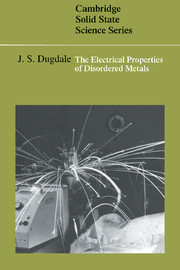Book contents
- Frontmatter
- Contents
- Preface
- 1 Context and content
- 2 Production and structure of metallic glasses
- 3 Electron transport in metals: introduction to conventional theory
- 4 Scattering
- 5 Simple liquid metals: Ziman theory
- 6 Phonons in disordered systems
- 7 Interactions and quasi-particles
- 8 Transition metals and alloys
- 9 The Hall coefficient of metallic glasses
- 10 Magnetoresistance
- 11 Electrical conductivity of metallic glasses: weak localisation
- 12 The interaction effect or Coulomb anomaly
- 13 The effect of the Coulomb interaction on conductivity
- 14 Influence of a magnetic field on the enhanced interaction effect
- 15 The thermopower of metals and alloys
- 16 Comparison with experiment
- Appendices
- Notes
- References
- Index
4 - Scattering
Published online by Cambridge University Press: 21 January 2010
- Frontmatter
- Contents
- Preface
- 1 Context and content
- 2 Production and structure of metallic glasses
- 3 Electron transport in metals: introduction to conventional theory
- 4 Scattering
- 5 Simple liquid metals: Ziman theory
- 6 Phonons in disordered systems
- 7 Interactions and quasi-particles
- 8 Transition metals and alloys
- 9 The Hall coefficient of metallic glasses
- 10 Magnetoresistance
- 11 Electrical conductivity of metallic glasses: weak localisation
- 12 The interaction effect or Coulomb anomaly
- 13 The effect of the Coulomb interaction on conductivity
- 14 Influence of a magnetic field on the enhanced interaction effect
- 15 The thermopower of metals and alloys
- 16 Comparison with experiment
- Appendices
- Notes
- References
- Index
Summary
The results that we have just obtained are rather formal but do give us some important insights into the nature of electrical conduction in metals. We see from equation (3.35) that this conductivity depends entirely on the properties of the conduction electrons at the Fermi level. Moreover, the properties involved are of two distinct kinds: the first kind relates to the dynamics of the electrons, as represented by the distribution of electron velocities over the Fermi surface. The second kind represented by τ is concerned with scattering, our theme in this chapter.
As we have already noted, scattering in a metal arises from anything that upsets the periodicity of the potential: disorder of the ionic positions, which is paramount in metallic glasses; random changes in chemical composition, which are of great importance in random alloys; impurities, physical imperfections, thermal vibrations, random magnetic perturbations and so on. Let us therefore see how the scattering from some of these can be treated.
In this chapter we deal in section 4.1 with some basic ideas about scattering theory; in 4.2 there is a very brief discussion of Fourier transforms because they appear so frequently in scattering problems; in 4.3 we look at the influence of scattering angle on resistivity; in 4.4 at the effect of the Pauli exclusion principle on scattering; in 4.5 we consider electron screening in metals because the mobile electrons can markedly alter the scattering potential by electrical screening of the scatterer; and in 4.6 the pseudopotential because this has been used very successfully to represent the scattering potential in some simple amorphous metals.
- Type
- Chapter
- Information
- The Electrical Properties of Disordered Metals , pp. 34 - 47Publisher: Cambridge University PressPrint publication year: 1995

